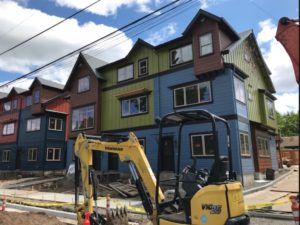An exchange between PSC commissioners on September 11 highlights the issues of demolition and displacement.
Eli Spevak, a developer sitting on the commission, spoke first, followed by Andres Oswill. Take a listen.
if the audio isn’t clear, here is what was said:
Spevak:
“I think there is a high likelihood that this policy will be an antidisplacement policy.because it creates – a lot of homes are going to come down no matter what, and we’ll see what happens. But if a home is replaced by three or four homes, they’re a lot less expensive to rent or to own, than under current rules. And we got strong feedback from non-profits working all over the city, close-in areas and further out, supporting these housing options in their neighborhoods, and they know that stuff pretty well. So I’m happy to see the verdict.
I recognize the Residential Infill Project is too discrete a scale, the homes, to try and get much if any regulated affordable housing, only a small amount is likely to come through this project. But create more homes that are smaller and less expensive than the market would otherwise build under today’s rules, I think there’s a high prospect there, which is encouraging.”
Oswell:
“I agree with Eli [note: Eli Spevak] that the net effect is that the homes that will be built will be smaller and likely to be more affordable. I think that shouldn’t prevent us from thinking about who is living in the homes that are being torn down and what is happening to those people and I think that’s where the disconnect comes from.
I like Chris’ [note: Chris Smith] idea of saying without the anti-displacement programs we should think twice about this project. I like the idea of looking back to Andre’s [note: Andre Baugh] previous amendment of focusing it on a narrow area.
I also think its worth considering a delay even if anti-displacement programs are created because I think it will take time to get people on the ground and to make a difference in programming. If the zoning goes into effect immediately and we start seeing development and people urging owners to buy their property, then the fact that we also have anti-displacement programs go into effect at the same time doesn’t help if they aren’t able to reach people before development does. So I think that should be considered.”
Both commissioners recognize that RIP will lead to a lot of demolitions of existing houses.
So what will happen to the people who are now living in the houses that are torn down?
Will they be able to live in the new RIP infill that is built where they used to live?
If they have $600,000 to $700,000, sure. That’s what newly constructed duplexes cost now. Here’s a typical example, on the market today. This one is on NE 11th in the Vernon neighborhood, where the median house price is $474,000.

Or, for between $400,000 and $480,000 plus HOA fees, they can buy a new row-house type condo. Here’s one in the Cully neighborhood, built by Commissioner Spevak’s company. These condos cost more than the median house price in Cully, currently $375,000.

Should Portland’s existing houses be demolished, and the families living there displaced, to build new RIP infill that is more expensive and less affordable than the housing that is demolished?
